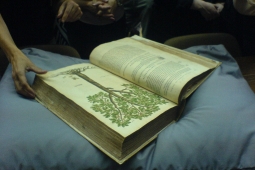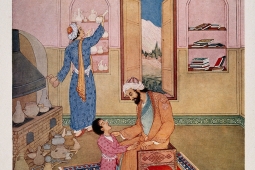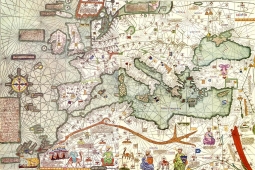The Spread of Disease along the Silk Roads: The Significance of Cultural Exchange in alchemy and the later development of Chemistry - Part.2
©Panlertb / ShutterstockThis article is the fourth in a series on the ways in which societies have historically responded to disease along the Silk Roads and how we might approach newly arising challenges today. It utilizes the Silk Roads as an instructive example of the benefits of an interconnected world built on collaboration and timely and reliable knowledge sharing. This article, divided into two parts, outlines the practice of alchemy as a precursor to the development of the scientific discipline of Chemistry, in turn an important element of the medical sciences. In doing so it identifies the role of the Silk Roads in helping fuel an incredible period of scholarship, particularly within the field of medical sciences, during the 8th and 9th centuries CE.
Outside of the many cosmopolitan city centres along the Silk Roads, the origins of chemical and pharmacological knowledge lay in other parts of Central Asia rich in the natural deposits of metals required for experimentation in alchemy. Deposits of raw materials namely lead, silver, and gold in Ferghana and Sogdia, and red salt in the Shahr-i-Sabz regions (in modern day Uzbekistan) were mined extensively. The availability of these natural resources served as the foundation from which alchemy and chemistry could flourish and were transported along the Silk Roads to reach the laboratories of alchemists. From the region, important archaeological finds include apothecary shops and chemistry laboratories dating from the late 8th century CE at excavations in Paikent, Bukhara, in modern day Uzbekistan. Here, various tools and associated technologies have been uncovered, many used in the chemical preparation of medicines such as furnaces, kilns, a hand-mill, glass vessels, and ceramic bowls, valuable items frequently exchanged along the Silk Roads. Many of these glass vessels were a type of apparatus used in chemical distillation known as al-anbiq, from where we derive the name of a distillation apparatus used throughout medieval history the ‘alembic’. Furthermore, a small amount of wax has also been excavated from these apothecaries and laboratories, a substance widely used in Eastern medicine as a component of medicinal ointments.
Indeed, many Scholarly texts regarding the significance of alchemy and chemistry reflected its high profile within the medical sciences of the time. Some examples included, Abu Nasr Mohammad al-Farabi (d. 950 CE), whose treatise, On the Need for the Art of Chemistry was translated into Latin in Europe the 12th century CE. It is an encyclopaedic work that went on to play a significant role in the development of European and Eastern medicine. The polymath and prolific writer Avicenna (980 -1037) revisited the ancient Aristotelean principles regarding the origins of metals and minerals in his work, Book of Healing (Kitab al-Shifa). He believed the theoretical basis of ancient Eastern medicine lay in the principles of mizaj, or the mixed nature of substances, including medicines, which reflected the properties of heat, cold, dryness and wetness. Similarly to the texts written during the Islamic golden age, work produced in Europe during the 12th century CE Renaissance relied on synthesising, via the translation of Medieval Islamic works, existing science and combining it with Aristotelian philosophy and new research. In the development of early modern science in the 16th century, these earlier works on alchemy and chemistry formed the basis of basic laboratory techniques, theory, terminology, and experimental method, some of which bear similarities to that still in use today.
Over time, the transformation and evolution of alchemy led to a more thorough understanding of modern chemistry, pharmacology, and pharmaceutics. Early studies into alchemy, with their attempts to understand the interactions and process of different materials, extract chemicals from natural resources, and synthesise existing knowledge from along the reaches of the Silk roads, established much of the groundwork for the modern science of chemistry. Thanks to the communication networks along Silk Roads, alchemists had access to a vast array of natural resources, including metals and minerals, objects for experimentation like glassware and ceramics, as well as a far reaching network of information available via translation. This allowed for the creation of pluralistic bodies of research, in an environment highly favourable to academic enquiry and knowledge transfer through rich channels of exchange.
Today, the Silk Roads are an instructive reminder that human movement, exchange, and interconnectedness are not solely contemporary phenomenon. Indeed, when it comes to the development of the sciences and technology, we do not occupy isolated worlds but a shared and interdependent one that flourishes when we interact, allowing knowledge to be widely shared. The UNESCO Silk Roads Programme promotes this unique history of cultural exchange and dialogue, which has weaved connections between peoples, and sparked innovation and development across the sciences, and many other fields, for thousands of years, providing the basis for rencounters and exchanges in the contemporary world.
Related Articles

The Spread of Disease along the Silk Roads: The Significance of Cultural Exchange in Alchemy and the Later Development of Chemistry - Part. I
Interactions across vast distances, such as those which took place along the historic routes of the Silk Roads, have made an undeniable contribution to the enrichment and development of the sciences via the transmission of both knowledge and the material resources for scientific enquiry.

The Spread of Disease along the Silk Roads: The Development of Medical Botany and Pharmacology
This article is the third in a series on the spread of disease along the Silk Roads. Its outlines the early development of medical botany and pharmacology during the Middle Ages and identifies the role of the Silk Roads in helping fuel an incredible period of scholarship, particularly within the field of medicine, during the 8th and 9th centuries CE.

The Spread of Disease along the Silk Roads: Smallpox
This article is the second in a series on the spread of disease along the Silk Roads. It details the spread of smallpox along the Silk Roads and the transmission of novel public health measures to combat it, including variolation and later, vaccines.

The Spread of Disease along the Silk Roads: Plague
This article explores the spread of plague, known as ‘the Black Death’, across the Silk Roads of the 14th Century CE. It examines ways in which people responded to the disease and looks at how we can respond to newly arising challenges today, utilizing the Silk Roads as an instructive example of the benefits of an interconnected world built on collaboration and timely and reliable knowledge sharing.




